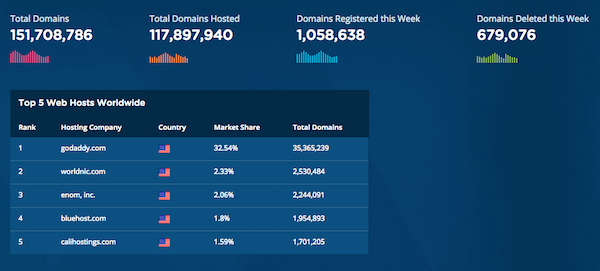google.overthrows-dotcom.hegemony

Even if the technical term doesn’t seem to ring a bell at first, every internet user is familiar with top-level domain names (TLD), since all addresses break down into three parts: sub-domain, domain name and top-level domain. (In www.google.com, for instance, “www” is the sub-domain, “google” is the domain name, and “com” is the top-level domain.)
Currently, there are 1078 TLDs registered with the Internet Corporation for Assigned Names and Numbers (ICANN). Since the beginning of the Internet era, domains with a “.com” TLD have been the most popular, and according to webhosting.info, 78.58% of all internet addresses today are registered with a .com extension — more than 119 million of the nearly 152 million domains that currently occupy the Internet. A handful of other TLDs — “.net”, “.info”, “.org” and “.biz” — comprise 21.41% of registered domains, which means that a scant 0.01% of domains are registered with the other 1073 TLDs. With this number of TLD options available today, why does .com still monopolize the market?
One of the many reasons other TLDs haven’t gained traction is their onerous registration price. The ICANN application fee alone is $185,000, and with additional annual registry fees the price tag can easily exceed $400,000. And in the event that several entities attempt to register the same TLD simultaneously, an auction takes place. In February 2015, for example, the right to register “.app” was sold for a staggering $25 million.
While in the past the high registration price for TLDs gave way to the .com hegemony, the market is now realizing that this trend is about to change, and Google is leading the pack.
On January 13, 2015, Google entered the web-hosting game with a new initiative, Google Domains. Knowing that the few trump cards in the web-hosting and website content management (CMS) industries are already in the hands of a few big-league players, Google is avoiding the status quo of hosting the most popular .com domains or competing with WordPress in offering an easy website building tool. Instead, by selling domain names with alternative TLDs, and leaving the website building to already existing CMS sites (such as Squarespace, Wix.com, Weebly and Shopify), Google is positioning itself to control the 0.01% of the TLD market.
In other words, Google is setting its sights on making new top-level domains popular. On domain.google.com, Google says that “New domain endings like .guru and .photography can help you find a meaningful address that stands out on the web.” Google emphasizes its ability to offer uniqueness to its creative users on its other sites as well. On their registry site, www.registry.google, Google explains:
.EDU has always meant education, .GOV government, .ORG non-profits. Today’s new domains are infinitely more open-ended. There will be new homes for creativity, for business, for explorers, comedians and professionals. What will .HOW mean? .EAT? .SOY? We have our ideas, but how you develop your piece of this online real estate is up to you.
Google Domains currently supports 172 out of the 1078 TLDs that are registered with ICANN, and Google set the stage on October 2, 2015 when it announced that all of its companies would be gathered under an umbrella named Alphabet Incorporated. Fittingly, you’ll find Alphabet Inc. at www.abc.xyz. How the TLD game will play itself out remains to be seen, but of one thing we can be sure: Google will be leading the way.











